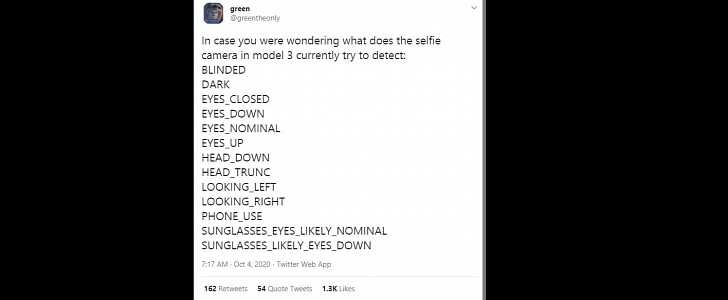Ever since the Model 3 started rolling out of the Fremont assembly plant, Tesla uses a cabin-facing camera in the electric sedan. Mounted in the rearview mirror, this feature became active earlier this year with the consent of the owner.
Now standard in the Model Y as well, the camera is specifically designed to “automatically capture images and a video prior to a collision or safety event.” Why, you may be wondering? Tesla says that it would “help engineers develop safety features and enhancements” but the Palo Alto-based EV company never detailed the specifics.
Tesla hacker green, on the other hand, is much obliged to report what he found out from the software that governs the driver-facing camera, and the events analyzed include phone use. As far as eye tracking is concerned, the Model 3 and Model Y know if the driver is looking up, down, left, right, normally, or if he/she has sunglasses on.
Given the way some people defeat Autopilot sensors with water bottles or whatever, it’s easy to understand why the camera is programmed this way. But on the other hand, owners who get into an accident can be denied insurance claims by Tesla in the case they weren’t paying attention to the road. A two-edged sword, if you will.
Don’t forget that the American automaker is currently running an insurance company as well, and you also need to consider that U.S. safety regulators may soon prepare a bill that would shut down Autopilot without a driver-facing camera. In any case, it’s increasingly apparent that Tesla is trying to protect itself from possible liabilities.
Elon Musk and company are not alone, though. Super Cruise – the semi-autonomous driving system from General Motors – also includes a cabin-facing camera to make sure that the driver is responsible as far as the act of driving is concerned. Going further down the rabbit hole, you also have to take into consideration that all cars linked to the Internet are selling data to third parties with or without consent.
The most telling example in this regard comes from technology columnist Geoffrey A. Fowler who “cracked open” a 2017 Chevrolet Volt for The Washington Post last year. In no particular order, Fowler discovered phone logs, addresses, emails, photos, how the car’s been driven, and the location of the car at almost any given moment.
Tesla hacker green, on the other hand, is much obliged to report what he found out from the software that governs the driver-facing camera, and the events analyzed include phone use. As far as eye tracking is concerned, the Model 3 and Model Y know if the driver is looking up, down, left, right, normally, or if he/she has sunglasses on.
Given the way some people defeat Autopilot sensors with water bottles or whatever, it’s easy to understand why the camera is programmed this way. But on the other hand, owners who get into an accident can be denied insurance claims by Tesla in the case they weren’t paying attention to the road. A two-edged sword, if you will.
Don’t forget that the American automaker is currently running an insurance company as well, and you also need to consider that U.S. safety regulators may soon prepare a bill that would shut down Autopilot without a driver-facing camera. In any case, it’s increasingly apparent that Tesla is trying to protect itself from possible liabilities.
Elon Musk and company are not alone, though. Super Cruise – the semi-autonomous driving system from General Motors – also includes a cabin-facing camera to make sure that the driver is responsible as far as the act of driving is concerned. Going further down the rabbit hole, you also have to take into consideration that all cars linked to the Internet are selling data to third parties with or without consent.
The most telling example in this regard comes from technology columnist Geoffrey A. Fowler who “cracked open” a 2017 Chevrolet Volt for The Washington Post last year. In no particular order, Fowler discovered phone logs, addresses, emails, photos, how the car’s been driven, and the location of the car at almost any given moment.
In case you were wondering what does the selfie camera in model 3 currently try to detect:
— green (@greentheonly) October 4, 2020
BLINDED
DARK
EYES_CLOSED
EYES_DOWN
EYES_NOMINAL
EYES_UP
HEAD_DOWN
HEAD_TRUNC
LOOKING_LEFT
LOOKING_RIGHT
PHONE_USE
SUNGLASSES_EYES_LIKELY_NOMINAL
SUNGLASSES_LIKELY_EYES_DOWN

